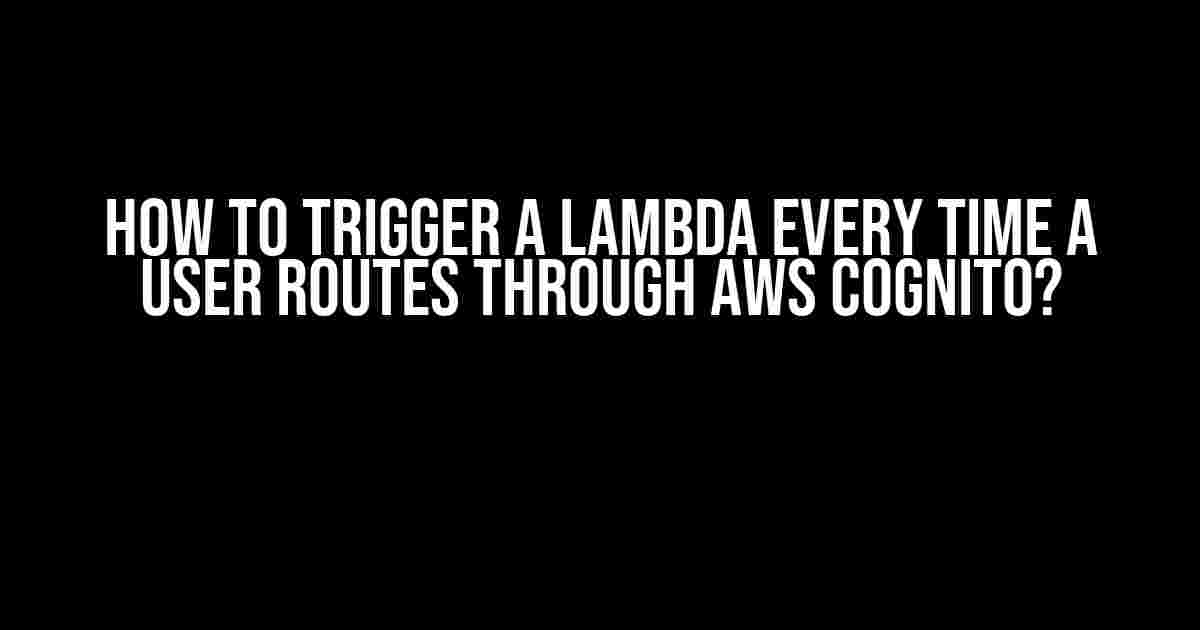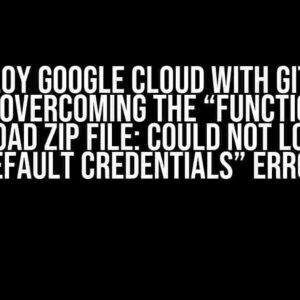AWS Cognito is a robust service offered by Amazon Web Services (AWS) that makes it easy to manage user identity and access control for web and mobile applications. However, what if you want to perform an action every time a user logs in or signs up through Cognito? This is where AWS Lambda comes into play! In this article, we’ll explore how to trigger a Lambda function every time a user routes through AWS Cognito.
Why Trigger a Lambda Function?
Triggering a Lambda function when a user interacts with Cognito can be incredibly useful in various scenarios. Here are a few examples:
-
**Welcome Email**: Send a personalized welcome email to new users after they sign up through Cognito.
-
**User Data Processing**: Process user data in real-time, such as validating user input, performing calculations, or updating user profiles.
-
**Analytics and Reporting**: Track user behavior and generate reports on user engagement, demographics, or other metrics.
-
**Security and Compliance**: Implement additional security measures, such as two-factor authentication or password hashing, to ensure compliance with regulations.
Prerequisites
Before we dive into the implementation, make sure you have the following set up:
-
AWS Cognito User Pool created and configured.
-
AWS Lambda function created and deployed.
-
AWS IAM Role with necessary permissions for Cognito and Lambda.
Step 1: Configure Cognito Triggers
In this step, we’ll configure Cognito to trigger a Lambda function when a user signs up or logs in. Follow these steps:
-
Sign in to the AWS Management Console and navigate to the Cognito dashboard.
-
Click on the “Triggers” tab and then click on “Create trigger”.
-
Select the “Post authentication” trigger type.
-
Choose the Lambda function you created earlier as the trigger target.
-
Set the trigger source as “User Pool” and select the user pool you want to associate with the trigger.
-
Click “Save trigger”.
Trigger Types
Cognito provides several trigger types that can be used to trigger a Lambda function. Here are some of the most common ones:
-
**Post authentication**: Triggered after a user has been authenticated.
-
**Pre sign-up**: Triggered before a user signs up.
-
**Post confirmation**: Triggered after a user confirms their account.
-
**Custom message**: Triggered when a custom message needs to be sent to a user.
Step 2: Configure Lambda Function
In this step, we’ll modify the Lambda function to receive and process the event triggered by Cognito. Follow these steps:
-
Sign in to the AWS Management Console and navigate to the Lambda dashboard.
-
Click on the Lambda function you created earlier and click on the “Configuration” tab.
-
In the “Environment variables” section, add a new variable `COGNITO_USER_POOL_ID` with the ID of your Cognito user pool.
-
In the “Function code” section, modify the code to receive and process the event triggered by Cognito.
exports.handler = async (event) => {
console.log(event);
const { userName, requestId, region } = event.request;
// Process the event here
return {
statusCode: 200,
};
};
Event Object
The event object passed to the Lambda function contains information about the user and the trigger event. Here are some of the key properties:
| Property | Description |
|---|---|
| userName | The username of the user who triggered the event. |
| requestId | A unique ID for the request. |
| region | The AWS region where the event was triggered. |
| userPoolId | The ID of the Cognito user pool associated with the event. |
Step 3: Test the Integration
Finally, let’s test the integration by signing up for a new user or logging in as an existing user through Cognito.
-
Sign in to your application using the Cognito signin page.
-
If you’re signing up for the first time, fill in the required information and submit the form.
-
After successful authentication or sign-up, check the CloudWatch logs for your Lambda function to see if the event was triggered successfully.
Troubleshooting Tips
If you encounter any issues with the integration, here are some troubleshooting tips:
-
Check the CloudWatch logs for any error messages or exceptions.
-
Verify that the IAM role has necessary permissions for Cognito and Lambda.
-
Ensure that the Lambda function is deployed in the correct region and has the correct handler.
Conclusion
In this article, we’ve explored how to trigger a Lambda function every time a user routes through AWS Cognito. By configuring Cognito triggers and modifying the Lambda function, you can perform custom actions in real-time when a user interacts with your application. Remember to test the integration thoroughly and troubleshoot any issues that may arise.
With this powerful combination of Cognito and Lambda, you can unlock new possibilities for your application, such as sending welcome emails, processing user data, or implementing additional security measures. The possibilities are endless!
Frequently Asked Question
Get the inside scoop on triggering a Lambda function every time a user routes through AWS Cognito!
How do I set up a Lambda function to trigger on every user login through AWS Cognito?
To trigger a Lambda function on every user login, you need to configure a Cognito User Pool Trigger. Go to the AWS Management Console, navigate to your Cognito User Pool, and click on “Triggers” in the left-hand menu. Then, click on “Create a trigger” and select the “Post authentication” trigger type. Finally, enter the ARN of your Lambda function and save the changes.
What is the difference between a pre-token generation and post authentication trigger in AWS Cognito?
The main difference between pre-token generation and post authentication triggers is when they are invoked. The pre-token generation trigger is called before the token is generated, allowing you to customize the token claims or reject the authentication request. The post authentication trigger, on the other hand, is called after the user has been successfully authenticated, making it ideal for tasks like logging or sending a welcome email.
Can I trigger a Lambda function on other events besides user login in AWS Cognito?
Yes, you can trigger a Lambda function on various events in AWS Cognito, including user registration, confirmation, password reset, and more. Just navigate to the “Triggers” section of your Cognito User Pool and explore the different trigger types available. Each trigger type allows you to execute a Lambda function in response to a specific event.
How do I pass user attributes to my Lambda function when it’s triggered by an AWS Cognito event?
When a Lambda function is triggered by an AWS Cognito event, the event object is passed to the function as an argument. This event object contains information about the user, such as their username, email, and custom attributes. You can access these attributes in your Lambda function using the event object, allowing you to perform user-specific tasks or logging.
Are there any security considerations I should be aware of when triggering a Lambda function from AWS Cognito?
Yes, when triggering a Lambda function from AWS Cognito, make sure to follow best practices for security. For example, ensure your Lambda function has the necessary execution role and permissions, and that you’re validating the event object and user attributes to prevent potential security threats. Additionally, be mindful of the data you’re storing and processing in your Lambda function, and ensure it’s compliant with your organization’s security policies.


